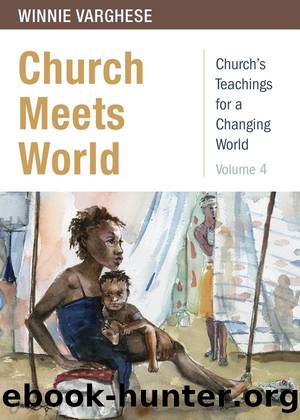Church Meets World by Winnie Varghese

Author:Winnie Varghese
Language: eng
Format: azw3
Publisher: Church Publishing Inc.
Published: 2016-08-01T07:00:00+00:00
Chapter 6
Christian
Love
Love is a primary concern for the church. As Christians we say God is love. We do not say that God is like love, or that love is one aspect of God. God, we say, is love.
As human beings we know love in human relationship: the love of and for parents, children, siblings, other family, friends. In particular, Christians place a high value on love that is mutual and expressed physically with security and stability in relationship with a chosen partner.
For these reasons and more, churches tend to engage the larger cultural conversation about human sexuality and marriage with great vigor. In The Episcopal Church, as in so many churches, that struggle comes to a head around questions of inclusion for lesbians, gay men, and transgender and bisexual people, especially who can be ordained and to whom one can be married.
First Strides toward Inclusion
In 1976 the General Convention of The Episcopal Church declared âhomosexual persons are children of God who have a full and equal claim with all other persons upon the love, acceptance, and pastoral concern and care of the Church.â
It was only in 1973 that the American Psychological Association removed homosexuality from the diagnostic manual of disorders. That shift occurred in the wake of the Stonewall Riot of 1969, the public act that launched the gay liberation movement, led by transgender and queer people of color in Manhattan.
In The Episcopal Church we have always had lay and ordained members in same-sex relationships, but the public profession of those relationships, and the understanding of them as honorable and equivalent to relationships between two people of the opposite sex, was a true innovation.
The bulk of the work toward the full inclusion of gay and lesbian persons in The Episcopal Churchâincluding the passage of the landmark resolution in 1976âwas led by Integrity, an organization founded by Louie Clay (née Crew) in 1974. Their work created the conditions for the Rt. Rev. Paul Moore, bishop of New York, to ordain Ellen Barrett, the first out gay priest in 1977.
The nature of the movement for the full inclusion of gay people in the life of the church changed in the 1980s and 1990s because of the HIV/AIDS pandemic. When HIV/AIDS was first emerging, young gay men were becoming sick and dying quickly and horribly, but homophobia prevented the funding of appropriate public health practices. The resulting activism to demand research and access to better treatment politicized the nation.
The motto of the time was âsilence = death.â Celebrities and ordinary people âcame outââmany at first because they were dying, but as time went on, because it was a matter of integrity or honesty. In the church, people who were known and beloved were now sick: friends, brothers, sons, musicians, priests, and vestry members. Priests came out in pulpits, and congregations and bishops had decisions to make about people they had known for a long time.
This was an extremely painful time for many, and lots of vocations to church leadership were lost. The arts community mourned losing the most talented of a generation in the AIDS crisis.
Download
This site does not store any files on its server. We only index and link to content provided by other sites. Please contact the content providers to delete copyright contents if any and email us, we'll remove relevant links or contents immediately.
The Lost Art of Listening by Michael P. Nichols(7169)
Why I Am Not A Calvinist by Dr. Peter S. Ruckman(4048)
The Rosicrucians by Christopher McIntosh(3373)
Wicca: a guide for the solitary practitioner by Scott Cunningham(3045)
Signature in the Cell: DNA and the Evidence for Intelligent Design by Stephen C. Meyer(2879)
Real Sex by Lauren F. Winner(2869)
The Holy Spirit by Billy Graham(2779)
To Light a Sacred Flame by Silver RavenWolf(2680)
The End of Faith by Sam Harris(2637)
The Gnostic Gospels by Pagels Elaine(2400)
Waking Up by Sam Harris(2332)
Nine Parts of Desire by Geraldine Brooks(2283)
Jesus by Paul Johnson(2230)
Devil, The by Almond Philip C(2206)
The God delusion by Richard Dawkins(2192)
Heavens on Earth by Michael Shermer(2190)
Kundalini by Gopi Krishna(2094)
Chosen by God by R. C. Sproul(2056)
The Nature of Consciousness by Rupert Spira(1983)
